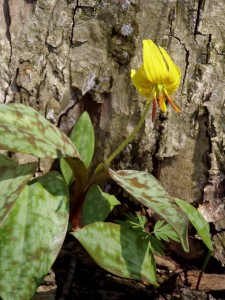by Allene Smith, Legacy Land Steward

Spring Beauty
There is a particular feeling to spring, like fingers thawing out after sledding, or the cool, damp air after a rain. With the thaw comes a resurgence of scent. Our feet are lighter without insulated boots (though the mud and puddles still require something waterproof), and our arms and legs move more freely, unencumbered by the many layers needed for winter walks. Our patch of land here in the Great Lakes Basin is waking up, and our charming spring ephemerals are some of the first to welcome back the green and growing world.
These botanical early-risers in deciduous forests take advantage of a brief window of time framed on one end by the warming soil and on the other by the leafing-out of the overstory that will shade the ground below. During this fleeting interval, the forest floor is damp from melting snow and spring rains, and warmed by direct sun. Within this niche, spring ephemerals, such as wild leek (Allium tricoccum), Dutchman’s breeches (Dicentra cucullaria), and wood anemone (Anemone quinquefolia) can grow, flower, and die back, returning to dormancy—all in the space of four to six weeks.
 If the change of seasons is to be celebrated, spring ephemerals are throwing the party. Their fresh, vibrant faces not only give us a welcome dose of color, they also provide newly-emerged insects with a food source when most other plants are just beginning to awaken. Ties between a spring ephemeral and its pollinator can be tight, even exclusive; the bee known as the spring beauty andrena (Andrena erigeniae) is highly selective, feeding on only two species in the genus Claytonia. One of the two is our native Claytonia virginica, commonly called Virginia spring beauty. Similarly, trout lily (Erythronium americanum) enjoys its own special partnership with Andrena erythronii, aka, the trout lily bee.
If the change of seasons is to be celebrated, spring ephemerals are throwing the party. Their fresh, vibrant faces not only give us a welcome dose of color, they also provide newly-emerged insects with a food source when most other plants are just beginning to awaken. Ties between a spring ephemeral and its pollinator can be tight, even exclusive; the bee known as the spring beauty andrena (Andrena erigeniae) is highly selective, feeding on only two species in the genus Claytonia. One of the two is our native Claytonia virginica, commonly called Virginia spring beauty. Similarly, trout lily (Erythronium americanum) enjoys its own special partnership with Andrena erythronii, aka, the trout lily bee.

Dutchman’s Breeches
Each year the emergence of spring ephemerals is subject to a variety of environmental conditions. If temperatures warm early and cool off again, the season may be long and drawn out, but produce few blooms. Trout lily may bloom for two weeks, or for only two days.
To accommodate this variability, Legacy is piloting a series of “Catch Them If You Can” events. We do the watching and waiting, then we’ll let you know when it’s prime time for a hike! Watch our Facebook page or sign up for text updates, and when the time is right, join us for a guided hike through Legacy’s Creekshead Preserve, known for its high-quality deciduous forest carpeted with lovely spring ephemerals. We hope to see you there!

 RSS Feed
RSS Feed
Count me in! I’d like to share some spring hikes with Legacy. It’s really special to go out with people who can identify the flowers and trees and mosses and bugs and snails and….